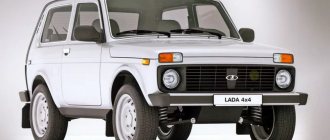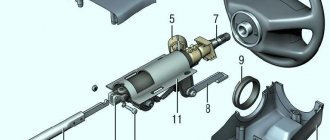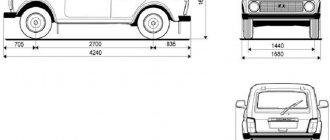08 April 2021 Lada.Online 6 122 0
The assembly and body production (AKP) of the LADA Niva Legend (formerly 4×4 or VAZ 2121, 2131) is located at the AVTOVAZ plant in Tolyatti. Currently, on a modern universal conveyor, which has undergone a complete modernization, LADA Legend cars are produced in 3-door and 5-door modifications, as well as car assembly kits. The website “At the Factory,” affiliated with AVTOVAZ, spoke in more detail about the production of the Niva.
The production of LADA Legend on a new assembly line allowed us to expand the color range and improve quality.
- The number of personnel in production is more than 2 thousand people.
- The total production area is 248,636 sq.m.
- Production capacity is designed for 30 vehicles/hour or 220 thousand vehicles/year.
- The amount of equipment is more than 2500 thousand units.
Welding
The body welding production specializes in the production of LADA Legend off-road bodies. The main consumers of the products are the production sites LADA Legend (production of painting and body assembly), VIS-AVTO, LADA-IMAGE, LADA WEST Tolyatti.
The production process involves about 1000 units of welding equipment, including: automatic lines, multi-point welding machines, assembly and welding stands, stationary welding machines, overhead welding machines, conveyor systems.
Car welding was moved from the 62nd building with a significant change in technology. A new concept for the welding process using robots was developed, and a digital model of the body was created. Automation in individual operations has reached 75%. The welding technology transfer project won the group's annual Renault-TdC Awards.
Assembly
To date, more than 2 million LADA Legends have been produced. Over the years of production, the car has been completely redesigned, and today's SUV differs from the first modifications in much higher comfort, reliability, dynamics and cross-country ability. The classic, recognizable design has been carefully preserved, with only a few new features, including a modified emblem on the radiator grille.
In addition to car assembly, we produce automotive components and spare parts.
How Niva has changed over 43 years
This year Niva turned 43 years old. Not a single AvtoVAZ car lasted on the assembly line for so long. What has changed in him during all this time? What updates and upgrades have taken place? All this is discussed in today’s material from Droma.
VAZ-2121 "Niva" - or now Lada 4x4 - is without a doubt the longest-lasting and most successful AvtoVAZ car. Over more than 40 years of production, 2.2 million copies of this legendary SUV with a timeless design were produced, of which almost half a million were exported to various countries. Some, by the way, consider the Niva to be the first crossover to appear in the world. The Lada 4×4 has a huge number of achievements: participation in the Paris-Dakar rally (1978–1988), climbing mountain peaks (Fujiyama - 3776 m in 1998, Everest - 5200 m in 1999, Himalayas - 5726 m in 1999), conquest of the North Pole (1998), work in Antarctica and various special services, filming in numerous Soviet and foreign films and the largest circulation among AvtoVAZ export products...
The Russian Lada 4×4 is the most capable SUV in the world, which can be bought for less than €10,000. This car has repeatedly confirmed its extraordinary cross-country ability in Droma tests
It is clear that no car can be produced for more than 40 years without any changes. Time passes, new technologies appear, new requirements for safety and comfort arise, and the consumer portrait of a potential buyer changes. To be honest, the Niva has basically remained almost the same - it is still the same ultra-budget, small-class off-road passenger car with a monocoque body, spring suspension and an almost unchanged appearance, permanent all-wheel drive and a locking center differential, with a "lowering" gear. and free cross-axle differentials. And yet, all these many years, constant work was carried out to modernize the model. Today we will talk about the main milestones in this history of changes, the appearance of various modifications. But first, let’s remember what the very first production Niva was like, which rolled off the VAZ assembly line in Tolyatti on April 5, 1977.
1977: the first Niva VAZ-2121
For the late 1970s, the design of the VAZ-2121 was very progressive. Especially in terms of the monocoque body and all-wheel drive with a center differential with the ability to lock it. Toyota released something similar - although in a much more modern interpretation - only in 1994, when it began production of the RAV4 model.
Under the hoods of the first Nivas, a 1.6-liter 4-cylinder carburetor engine with a timing chain drive was installed, based on the engine from the VAZ-2106 and developing 80 hp. and 116 Nm. In addition, the 4-speed gearbox and rear axle gearbox were also borrowed from the “six”. The interior also resembled a “six” - metal panels on the top, a two-spoke steering wheel with a thin rim, the same dashboard, classic round “Zhiguli” air ducts at the top of the front panel, front seats... The most obvious and obvious difference was the presence of two additional levers next to the selector “ mechanics" - one included the lowering row, and the second blocked the "center". This scheme is still used on Lada 4x4.
In these “sections” and the photo below, you can examine in detail the design of the VAZ-2121: a monocoque three-door body, a spring suspension (in the front, independent on wishbones, in the rear - an axle with a Panhard rod), a longitudinally mounted engine, a manual gearbox with a transfer case and the possibility of locking "center", located under the hood "spare"
The Niva immediately became very popular - after all, it was the only Soviet all-wheel drive passenger car with a similar level of comfort and cross-country ability. Some components and assemblies were considered quite reliable (for example, the engine or the “indestructible” 4-speed manual transmission), but at the same time, like almost any new car, the VAZ-2121 in the first years of production had quite significant problems. Below we provide a list of the most common ones. We had to wait decades for solutions to many of these shortcomings.
The most common problems of the first Nivas
Standard tires VLI-5
Poorly suited for driving on asphalt: high noise level, low grip, rapid wear.
Body corrosion
The rapid appearance of rust spots on the tailgate (with a very high loading height), sills, joints of the pillars and roof, and the floor in the area where the transfer case is mounted.
Poor sealing
Worthless seals, water in the cabin even after heavy rain.
Radiator fan mechanically driven by crankshaft
Insufficient air flow at idle, overheating.
Bad "stove"
Noise in the fan, leaking heater tap (antifreeze in the cabin), improperly organized airflow, cold in winter.
Cardan crosspieces
They require constant maintenance, fail quickly, and are difficult to replace.
Clutch
You can “burn out” the clutch due to a weak engine in a couple of off-road trips.
Transfer case
Constant hum, vibration, souring of the control mechanism.
Front-wheel drive (CV joints)
Wear of anthers, possibility of rupture under severe off-road loads or presence of blocking at the front.
Front wheel wheel bearings
Requires constant adjustment and lubrication.
Rear drum brakes
The need to constantly adjust the gap.
1994: VAZ-21213 “Taiga”
For 15 long years, the VAZ-2121 was produced without any major upgrades, the owners already knew about all the “jambs”, knew how to fix them to the best of their ability, and placed a cap with earflaps on the central tunnel to reduce the amount of noise and hum from the transfer case. The first transitional modifications appeared in 1993, and fully modified Nivas rolled off the assembly line in 1994. At first, they even wanted to give the VAZ-21213 version its own name - “Taiga”, but it didn’t catch on. Nevertheless, the number of changes made was significant.
Firstly, Niva has changed in appearance. The rear door with a different handle was extended to the bumper, which made loading and unloading much easier, and new lights appeared on the sides. Secondly, they began to install a VAZ-21213 engine under the hood with a volume increased (due to the longer piston stroke from the VAZ-21083) to 1.7 liters and a Solex carburetor. It also changed the profile of the camshaft cams, which made it possible to expand the intake and exhaust phases, improve cylinder filling and increase torque to 127 Nm. But the mechanical fan drive from the crankshaft remained. But on the engine with single injection - 21214 - electric fans were already used. True, this engine was initially used only on export versions, and the Russians had to wait for the injector for almost ten more years. Thirdly, the Niva has been equipped with a 5-speed manual transmission ever since. But the reliability of this gearbox turned out to be worse than that of the old one: converted from a “four-speed”, it suffered from oil starvation of the fifth gear gear block, and was also not of such high quality materials. Fourthly, after 1994, the output shaft of the gearbox and the input shaft of the transfer case began to be connected by a drive shaft, in which the cross was replaced with a CV joint, which made it possible to slightly reduce noise and vibration.
This is one of Drome's most popular videos, already gaining almost 2 million views! In it, the Lada 4x4 is compared with the Renault Duster in the same off-road conditions:
In the same year, the most significant (up to 2019) change in the interior occurred. New seats were installed, the “tidy” from the “eight-nine” settled in front of my eyes, a different, more “meaty” steering wheel and other, very flimsy air ducts appeared.
Niva engines can run on almost any fuel!
Over the course of its long life, Nivs have featured a variety of power plants under their hoods. In addition to the “classic” 4-cylinder gasoline units, the Peugeot XUD-9L diesel engine with a volume of 1.9 liters and a power of 65 hp was installed on export cars (the VAZ-21125 was produced at the Moscow region enterprise LfaExport JSC), and in 2001 at the Moscow International At the auto show, they even demonstrated a prototype of “Antel” using... a hydrogen installation!
1995: VAZ-2123 - long-wheelbase 5-door modification
Niva had three-door extended versions until 1995 (for example, the VAZ-212180 Fora, “stretched” by 300 mm or the VAZ-2129 Kedr), but it was this year that official sales of the five-door modification of the VAZ-2131 began with wheelbase increased by as much as 500 mm. This version is still in service - an excellent option for those who want to win in convenience, spaciousness and comfort at the expense of a slight deterioration in off-road performance.
By the way, at first the five-door cars were equipped with a 1.8-liter power unit 2130 (82 hp, 139 Nm), which was famous for the factory defects of the cylinder block in early versions, the constant need to adjust the valves and instability at idle speed .
In this video, the previous generation Suzuki Jimny competes with the long-wheelbase 5-door Lada 4×4:
2001: Niva becomes Lada 4x4
In 2001, AvtoVAZ sold the Niva brand to the joint venture GM-Avtovaz, which mastered the production of the Chevrolet Niva car. In return, the Lada 4×4 received a number of modifications mastered at Chevy. A Valeo clutch was installed, and the problem with low brake performance was solved by installing a new 9-inch vacuum booster and a larger diameter master cylinder (22.22 mm versus 20.64 mm). There are non-adjustable wheel bearings, new steering knuckles in the front suspension with a reduced rolling arm, as well as more powerful silent blocks of the lower arms, optimized for the length of the compression and rebound buffer. The dimensions of the shock absorbers were increased, and the lower rear mounts were changed, as was the position of the longitudinal rods. The front gearbox was moved and attached to the front suspension beam.
2002: engine 21214 with central fuel injection
In 2002, AvtoVAZ finally launched a car with an injection 1.7-liter engine 21214-20 (81 hp, 128 Nm) with mono-injection and a single-row timing chain (previously there was a double-row), meeting Euro-2 emission standards . About 75% of the parts of this engine were borrowed from the VAZ-2131, but at the same time it could not do without a number of new devices and sensors: a Bosch or “January” controller, a crankshaft with a long (40 mm) crank radius, a cylinder head with holes for valve timing sensor and receiver studs, hydraulic valve compensators instead of adjusting bolts and PCV and idle speed sensors.
2009–2011: changed appearance, power steering and engine 21214M
The next update of Lada 4x4 began in 2009. Externally, the Niva has not changed much - a new radiator grille, daytime running lights and turn signals have appeared, as well as mirrors of a slightly different shape. Inside, the seat upholstery has changed, the electronic instrument panel is now from the VAZ-2115, and the rear seat began to fold in two stages - first the cushion, and then the backrest. But there were plenty of technical innovations.
They began to install a modernized VAZ-21214M unit under the hood, which was equipped with distributed injection and complied with Euro-3 environmental standards (and then to this day - Euro-5). To eliminate coolant leaks, new gaskets with an elastic silicone bead were introduced, which retain their properties throughout the entire service life of the vehicle and do not require tightening. The pump used a new imported seal. Some modifications began to be equipped with ABS, the diameter of the Valeo clutch increased from 200 to 215 mm, and since 2007, the Lada 4×4 began to be equipped with power steering.
2014–2019: Lada 4×4 Urban, air conditioning and further modernization
In 2014, the Lada 4×4 began production of the “city” version Urban - plastic bumpers, a new radiator grille, black previously chromed parts, athermal glass, metallic colors and R16 alloy wheels. The interior features a new “chubby” steering wheel with a smaller diameter, improved sound insulation, a VDO instrument panel, extended windshield wipers, cup holders on the center tunnel, heated seats, power windows and mirror controls, and most importantly, air conditioning!
But the list of internal changes for the Lada 4×4 turned out to be quite impressive. The crosspieces on the cardan shafts of the axle drives have finally given way to CV joints, which has reduced noise and vibration. Finally, the body began to be painted using cataphoretic and polyester primers, which improved corrosion resistance. Also over the years, a number of smaller innovations were introduced: ABS and Isofix fastenings appeared on the five-door version, the rear seat belt fastenings were moved, new rear door upholstery was used, double-sided windshield washers and a metal cord sheath for the hood opening drive cable.
Comparison of the penultimate reincarnation of the 2022 Lada 4×4 with the new Suzuki Jimny off-road:
2019: latest update so far
We still believe that the interior of the very first Niva looked most organic and charismatic. All its updates over the past 40 years resembled some kind of semi-finished product, although Lada acquired things necessary for comfort and safety, such as an airbag (only a side one! - for the correct operation of ERA-GLONASS) and air conditioning. It seems that AvtoVAZ also understood the need for radical changes, and finally we have seen them: since last year, all Nivas have been sold with a completely new interior and slightly modified appearance.
All versions (not only Urban) are now equipped with plastic bumpers, and fog lights are also implanted in the front one. The engine now sits on new mounts. But the main differences are in the interior. The most noticeable change is the completely new front panel. The “tidy” is now similar to those of Vesta or XRAY - with orange scales, radial digitization and large arrows. But the most important thing is that an on-board computer with a fuel consumption sensor has finally appeared. Although this is unlikely to greatly console the future owner, because the Niva traditionally cannot boast of efficiency. In the center is a completely new climate control unit with three classic “knobs”—always jamming sliders are a thing of the past! Above it are a row of backlit buttons (turning on the rear wiper and heated glass, air conditioning and recirculation) and other, much neater, air ducts. Below there are a pair of 12-volt outlets. The light control unit is also new, as are the fog light switches. The front seats have changed shape, padding, as well as the sliding mechanism. Massive headrests appeared in the back row, retracting almost flush. New seals were installed in the doorways, and the doors themselves acquired new limiters. The ceiling is now covered with a pile covering, there is a modernized lock at the tailgate, and in the luggage compartment itself there is another 12 V socket. Among the little things - a new lampshade and a button for the ERA-GLONASS system. It cannot be said that with such an interior, the Niva has become a modern car, but still, in both its appearance and functionality, it is the best in all these 43 years.
They say that in 2023 AvtoVAZ plans to begin production of a completely new Lada 4×4. True, this date is constantly being postponed, and no one has 100 percent confidence in the appearance of the new Niva in a couple of years.
And it will be a completely different story using Renault units. Thus, for some time there will be as many as three Nivas left on the market - the old Lada 4×4, the Chevrolet Niva and the new Lada 4×4. It’s a pity, of course, but the “old lady” will soon have to retire one way or another. However, who knows, maybe she will also celebrate her 50th birthday on the assembly line?
Technical characteristics of Lada 4×4
| engine's type | Gasoline L4 |
| Working volume, cubic meters cm | 1690 |
| Max. power, hp at rpm | 83/5000 |
| Max. torque, Nm at rpm | 129/4000 |
| type of drive | Constant full |
| Transmission | 5-speed manual transmission |
| Front suspension | Independent wishbone |
| Rear suspension | Dependent spring |
| Brakes | Disc front and drum rear |
| Dimensions (L/W/H), mm | 3640x1680x1640 |
| Wheelbase, mm | 2200 |
| Curb weight, kg | 1285 |
| Max. speed, km/h | 142 |
| Acceleration 0–100 km/h, sec. | 17,0 |
| Fuel consumption (combined), l/100 km | 9,9 |
| CO2 emissions, g/km, eq. Class | N.D./Euro-5 |
| Ground clearance, mm | 200 |
| Luggage compartment volume, l | 265/585 |
| Fuel tank volume, l | 42 |
| Tire size | 185/75 R16 |
| price, rub. | from 566,900 to 685,900 |











